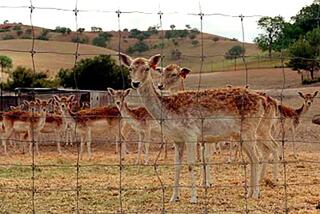Farm conservation program ‘under the gun’
- Share via
The farm bill is a favorite target of budget-cutters and those looking to reduce the size of government, particularly because about 80% of it encompasses food stamps and nutritional programs. However, it also contains some of the most successful conservation programs in our nation’s history, and those are now threatened with the ax, including the popular 1985 Conservation Reserve Program.
Don’t remember rural life before the CRP? Well, there wasn’t as much wildlife. Especially not ground-nesting birds like quail or pheasants or ducks that need grassy fields for cover.
The CRP and its sister programs under the Conservation Title XII of the Farm Bill, such as the Wetlands Reserve Program and the Wildlife Habitat Incentive Program, are easy to understand. Farmers and landowners can volunteer to put some of their acreage to grass or other cover, or even restore habitat, and get a government check to defray the costs. Often it’s acreage better suited to grass or swamp than crops. And it works.
“There seems to be a particularly large bulls-eye on CRP right now,” says Dave Nomsen, vice president of government affairs for conservation groups Pheasants Forever and Quail Forever, who has been involved with shaping the last several farm bills. They come up for renewal every five years, and the current bill must be renewed or extended by December 2012.
The CRP is currently capped at 32 million acres nationwide. That’s a lot of habitat for critters. But the number of acres enrolled in the program is falling and folks in Washington are looking to cut it, by a lot. For instance, in the budget talks undertaken last fall by the so-called budget “super committee,” which failed to reach an agreement, there was a proposal on the table to cut the program to 25 million acres, and others were vetted that would have cut it in half.
“It’s under the gun from a number of different fronts,” adds Nomsen. “If you look at what’s happening with commodity prices, land values, commodity stocks on the planet, ethanol, biofuels, changes in technology, larger farming equipment, you add up all of those factors, and it’s a real challenge right now to put CRP on the landscape.”
With corn and other crop prices at record highs, for example, conservation programs are losing their luster. Nomsen points out that the Plains states removed 800,000 acres from conservation programs in 2011 and put most of it into cultivation. Nationwide, 6.5 million acres in the program are set to expire in September.
With each drop in acreage, we’ll see a drop in wildlife. In the December issue of Wyoming Wildlife magazine, editor Chris Madson writes about the Conservation Title, noting: “In the decade from 1975 to 1984, South Dakota estimated an average pheasant population of 3.2 million birds. From 2000 to 2009, with conservation programs firmly in place, the population averaged 8.3 million.” He pulls up similar numbers for sharptail grouse, mule and whitetail deer, ducks and other wildlife.
Before the CRP, in the late 1950s, there was a similar program called the Soil Bank. When it ended in 1965, animal populations plummeted.
It’s not just animals that benefit from the extra habitat. The fallow acres also help ensure healthy human communities.
“The track record is clear: if you add up the benefits of CRP for soil erosion, water quality, wildlife, aesthetics, all of those factors, it clearly is a successful use of federal dollars,” says Nomsen.
This year, however, conservationists are bracing for cuts, despite the fact that the programs have champions in both parties and both houses of Congress. Possibly big cuts. Something to track in the big budget battles of 2012.
RELATED:
California wolf inspires new state Web page
USC researchers discover new, cheaper CO2 capture
And the 2011 awards for bad climate science go to...






